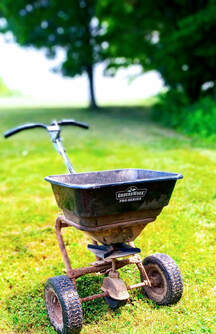 Overseeding your lawn is a really important part of having a thicker, healthier and greener lawn with less weeds. It really isn't difficult to do, but it does require some knowledge to get the most germination for your buck. Read on to learn the why, what, how, when and where of overseeding your lawn. Keep in mind, we're a West Michigan-based company, so our recommendations are targeted for this region. How should you overseed? When overseeding your whole lawn you should follow these practices: 1. Mow your lawn the day of or the day before you overseed, and set your mower a notch or two lower than you normally mow at (not the lowest or second-lowest settings; you'll scalp your lawn). You should also either bag the clippings or rake up as many clippings as you can before putting the seed down. Now both of these practices (mowing shorter and removing the clippings) go against my normal recommendations, but there's a reason for it. Mowing the grass shorter than normal allows the seed to move down to the ground easier. It also allows you to go a little longer before you need to mow again so you're not sucking up the baby seedlings. Removing the clippings from the lawn before overseeding also helps the seed work their way down to the soil easier. 2. Using a push spreader or hand spreader, apply the grass seed mix just as you would fertilizer, in even rows, in a snaking motion across your lawn. It's best to do it on a calm day, when the grass is dry. 3. Water immediately for 20-30 minutes. Then for the next 14 days, water daily for about 10-15 minutes in the morning. If it's an especially warm day (80-degrees or more), you might want to do another 10-15 minute watering in the evening. Short daily waterings aren't normally recommended for your lawn, but think about these seeds as babies-- they need constant help from you until they grow roots and can find water on their own. Until these seeds germinate and grow to about 1/2-inch tall, you need to give them water every day. The soil must remain damp for the first two weeks, or the seeds won't sprout, and if the new seedlings have sprouted, they'll whither and die. 4. After about 14-20 days, feel free to mow again. This may mean letting your lawn get a little shaggier than it normally looks, but tough it out so that your new grass has a good chance to germinate, take root and begin its new life on your lawn. Basically, go as long as you can before mowing again. But what if you've got larger patches in your lawn where grass just doesn't seem to do very well? You've tried seeding there before, only to have it not germinate or, if it does germinate, die off shortly after. Or maybe you've got areas where pets have killed the grass with their urine. This could mean you've got bad soil there. I'd recommend putting down some organic matter-- a compost/topsoil blend would be good. Even better than that, we sell a blend called Lawn Soil, which we've been using for a few years now with amazing results. It's specially formulated to help seeds germinate quickly and new grass to be thick and lush. Once you've put down some organic matter on the area, you can overseed as recommended above.
0 Comments
Your comment will be posted after it is approved.
Leave a Reply. |
